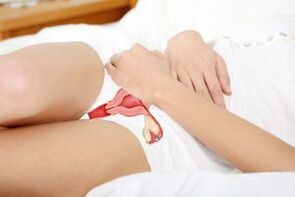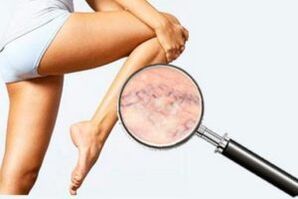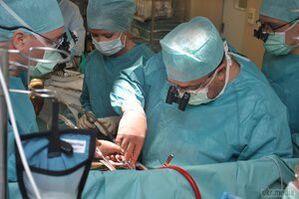Small pelvic varicose veins, unlike a similar disorder in the lower extremities, are not always noticeable but are very detrimental to health. It can lead to impaired blood flow to internal organs and impaired function.
The difference between varicose veins and healthy veins
A healthy blood vessel wall is always in good condition - this allows blood flow to be maintained.
The walls contract, though not as much as in the arteries. This effect is enhanced by contractions of smooth and skeletal muscles.

All the veins under the heart, i. e. in the limbs, abdomen, pelvis, chest, have valves on the walls. The "pockets" formed by the vascular endothelium.
They are arranged so that the blood flowing into the heart passes unhindered. It fills the valves in retrograde motion and closes the vessel.
Blood flows from the periphery to the heart despite gravity.
The varicose vein undergoes a number of changes in the valve assembly. Their wall tone decreases and their permeability increases. This creates the conditions for blood to stagnate.
Some of the fluid circulates, causing an overflow of healthy blood vessels. And it also provokes a violation of the tone in them.
What is and what is dangerous
Varicose veins affect peripheral blood vessels in any area of the body.
Manifestation of foot pathology is most noticeable - it causes a significant aesthetic defect. But the same phenomenon in the organs of the abdomen or small pelvis is asymptomatic for a long time.
Most dangerous to the female reproductive organs, less commonly to the bladder. Varicose veins of the rectum present with hemorrhoids.
There can be various causes of pelvic varicose veins. The disease leads to impaired blood flow in the reproductive system, as a result - deterioration of its function.
A woman may notice changes in the menstrual cycle, pain, and the appearance of signs of hormonal abnormalities. With physical action, the vessel may rupture and bleed.
Causes
It is multi-factorial, that is, it results from the convergence of several reasons. Including:
- hereditary predisposition;
- lack of physical activity;
- pregnancy complications;
- overweight; diseases of the urinary system and intestines
- ;
- Hard physical work.

The presence of one or even more detrimental factors does not mean that the pelvic veins are dilated. This indicates a high risk of such pathology.
Women with children suffer more often than men.
The first signs usually appear around the age of 40 or later during pregnancy. The actual onset of the pathology occurs much earlier.
Degrees
There are three stages in varicose veins:
- Mild - damage to one or more peripheral blood vessels. In most cases, it may be asymptomatic, transient, and re-examination is required.
- Medium degree - dilation of the parametrium - the outer shell of the uterus or the large veins of the myometrium - muscle membrane. It causes menstrual disorders and deterioration of health.
- Severe degree - varicose veins and edema of most organs of the female reproductive system. It causes serious violations in the genital area, high risk of disease and infertility.
Symptoms
Symptoms vary depending on the location and extent of the lesion. In the initial stage, it most often progresses without symptoms.
With the onset of the disease, itching, heaviness and pain in the external genital area occur.
The intensity of these feelings varies depending on the phase of the menstrual cycle. They may increase during bleeding and subside after a few days.
A woman may notice that her menstruation has become more painful and abundant. Sex becomes painful, there are problems conceiving and wearing a pregnancy. <
Diagnostic Methods
There are several ways to identify the disease.
The first and simplest of these is a gynecological examination. It reveals dilated veins in the skin, vaginal wall and cervix. Its data indirectly indicate the cause - endometriosis, cervical erosion.
The most reliable method is gynecological ultrasound. Its advantage is that it allows the identification of the parameter, the fallopian tube and the enlargement of the ovaries. The results of this study provide more complete information about the state of the reproductive system.
In controversial cases, MRI, vaginal smear, sex hormone blood test, and diagnostic curette are prescribed.
Which professional to go for help
Treatment is performed by a gynecologist in collaboration with vascular surgeons. Endocrinologist consultation is required for hormonal disorders. Because the disease is multifactorial, other professionals may be involved in its treatment if necessary.
Because the disease is multifactorial, other professionals may be involved in its treatment if necessary.
Treatment Methods
The reproductive system should be examined before starting treatment. Identify possible pathologies. As a general rule, the disease is caused by other disorders.
An integrated approach is used for greater efficiency. They use several therapeutic methods at the same time, which makes them more successful.
Medication
Includes taking medications to increase the tone of the vessel wall - Diosmin.
To reduce vascular wall permeability, select:
ascorbic acid; nicotinic acid;They can be taken even during pregnancy and after childbirth if the first symptoms have just appeared.
Your doctor may also recommend blood thinners such as acetylsalicylic acid, vitamin K.
Use during pregnancy is only allowed after consultation with an obstetrician-gynecologist if the benefits outweigh the possible harm.
Compression and sclerotherapy
Wear compression stockings and a belt to prevent varicose vein complications. They put pressure on the vessels of the external genitals, preventing them from overflowing.
As a result, normal or near-normal venous outflow is maintained in the small pelvis. The degree of compression is determined by your doctor. You can also wear such underwear during pregnancy.
Sclerotherapy is a procedure in which a special drug is injected into a blood vessel that stimulates a short-term inflammatory response. And then - the complete occlusion and narrowing of the injured vein. The blood flow stops completely.
This procedure can be performed in 2-3 trimesters of pregnancy if there is no contraindication.
Action
Surgical treatment is the removal of the affected area. There are several ways to do this, depending on the patient's condition.

In some cases, partial ovarian resection is required. And sometimes complete removal of the uterus / fallopian tube.
In women of childbearing potential, doctors try to preserve the reproductive organs.
Physiotherapy exercises
These are exercises that improve blood flow and reduce venous congestion. Most effective:
- "birch";
- bends in the back knee-elbow position;
- Exercises to lift the leg and sacrum area.
They help blood flow through gravity.
Folk remedies
Traditional treatments are less effective than hospital therapies, but can significantly improve patient well-being.
Herbal baths are used for this - willow, oak branches, caddy and chamomile grass.
They have a calming effect, reduce tension and stimulate blood flow.
Prevention Tips
It is impossible to completely eliminate all factors that affect venous outflow. But you can reduce their influence. For example, take time to exercise, keep your weight normal.
It is especially important to prevent diseases during pregnancy. Monitoring nutrition and physical activity is essential during this period. And also for enough vitamins.
Small pelvic varicose veins in women: symptoms and causes, diagnosis and treatment
Pelvic varicose veins are more common in women of childbearing potential.
The disease can be easily confused with many gynecological diseases, so proper diagnosis and proper treatment are needed.
Varicose veins are much more common today than they were decades ago. The reason for this is the sedentary lifestyle.
The disease involves a decrease in the elasticity of the venous wall. It can be called in different ways: pelvic varicose veins, varicocele, chronic pelvic algae syndrome. More often, women of childbearing potential suffer from the disease.
Occurrence factors
The most common cause of varicose veins in womenis changes in pregnancy and the body's hormone ratio.
The following factors also lead to this:
- use of hormonal drugs;
- Continuous use of intercourse interruption for contraception;
- sexual dysfunctions: pain during intimate contact and lack of orgasm;
- many and complex births;
- sedentary and sedentary lifestyle or excessive physical activity;
- congenital connective tissue disease, weakness of venous valves and blood vessel walls.
The risk of varicocele increases in women with high levels of the hormone estrogen.
This video on the symptoms and treatment of pelvic varicose veins in women:
Symptoms
When the disease begins in adolescence, the pathological symptoms are often absent at all.
The girl may feel completely normal. And changes in the pelvis are detected by chance using detailed research methods.
In adolescents with varicocele disease, the only symptom will be severe mucosal vaginal discharge, which may lead to treatment of colpitis.
The most common symptom of varicose veins occurs after a woman reaches reproductive age. It is a pain syndrome that affects more than 95% of patients.
It can bother a woman from time to time or continuously, but it can be observed throughout life and becomes pronounced during menopause.
Pain increases after ovulation, in the second stage of the cycle.
Appears in the lower abdomen, sore or acute, may give to the lower back or sacrum.
Pelvic varicose veins may show the following symptoms:
- severe premenstrual syndrome;
- regular vaginal discharge. Whitish, transparent;
- increased sensitivity of the skin in the perineum and vaginal mucosa;
- menstrual disorders;
- feeling of pressure and difficulty in the small pool, especially if you stay in one position for a long time;
- pain may occur at the end of the day during intercourse;
- sometimes urinary pathologies appear;
- pain may occur at the end of pregnancy;
- pain is observed during abdominal examination;
- Swollen veins may appear on the outside of the thigh, on the external genitals, on the buttocks;
- possible swelling of the vagina and vulva;
- Due to fluid spillage into the pelvic area, body weight may increase by 2-4 kg periodically;
- possible apathy, weakness, constant fatigue, depression.
What causes pelvic varicose veins
Varicose veins are a common pathology of the circulatory system. Residents of economically developed countries are most susceptible to the disease. In some regions, one in three suffers from it. In this article, you will find helpful information about pelvic varicose veins: the symptoms, treatment, and first manifestations of this form of varicose veins.
What is a pool varicose vein? Pelvic varicose veins occur due to poor blood flow. The dishes are filled with too much liquid. Excessive pressure causes the walls of the veins to become inflamed. The chronic process leads to excessive elongation of the blood vessels.
Although pelvic varicose veins primarily affect the genital blood vessels, the patient should not be observed by a gynecologist or urologist, but by a phlebologist or vascular surgeon.
With varicose veins in the pelvis, the photograph clearly demonstrates the excessive elasticity of the vessel wall on an enlarged scale.
There are people who have a disease such as pelvic varicose veins, the symptoms and manifestations of which can be confused with some diseases of the reproductive system.
Symptoms of pelvic veins
Many patients receive inadequate treatment before professionals recognize pelvic varicose veins. The symptoms of the disease are not specific - they cannot be used to make an accurate diagnosis:
- Discomfort in and over my eyes, accompanied by painful feelings. Pain is characterized by a dull and pulling nature, the intensity of manifestation increases with physical exertion, prolonged sitting and standing, overheating, and excessive cooling. Due to the close location of the venous vessels and the spine, patients complain of discomfort in the lumbar region. The pain is often felt in the perineum.
- Manifestation of varicose veins in the external genitalia, buttocks and upper legs.
- General weakness.
- Depression, apathy, feeling depressed.
Dilated genitals are unconditional signs of varicose veins. The photographs show poker and nodular protrusions on patients ’skin.
Symptoms in women
Pelvic varicose veins have symptoms that are common in women.
- Severity of premenstrual syndrome.
- Dysmenorrhea.
- The pain of intercourse.
- Mucus from the vagina.
- Swelling of the external genitalia.
Symptoms in men
Symptoms in men are different from female manifestations of pelvic varicose veins.
The small pelvis (varicose veins) in men is asymptomatic in most cases. Only the following manifestations may be characteristic of this sex: intermittent pulling pain and heaviness in the scrotum area.
Causes of Occurrence
The pelvis (varicose veins) alone, the underlying causes of the appearance are quite prosaic in nature, from the consequences of weight lifting to bad habits and a sedentary lifestyle. Women of childbearing potential are more likely to suffer from this disease. With the first manifestation of menopause, the development of this pathology is significantly reduced.
Listing the main causes of varicose veins in the small pelvis include:
- Disruption of normal blood circulation to the abdominal organs during pregnancy.
- A sedentary lifestyle in which a lot of time is spent sitting or standing.
- Weight lifting work.
- Violation of the pelvic blood vessels due to interrupted intercourse.
- Use of hormonal contraceptives.
- The negative effect of cigarette smoke on the general condition of blood vessels.
If pelvic varicose veins are detected after a diagnostic examination, treatment is likely to include a number of measures to alleviate the consequences, reduce pain, and at the same time prevent further progression of the disease.
Treatment of pelvic veins
For pelvic varicose veins, treatment consists of medication, special exercises, the use of compression products, and adherence to a prescribed diet. Surgical intervention is performed when methods of conservative therapy are ineffective.
If you want to buy compression products, keep in mind that without proper practice, it is not easy to add them. Don’t make it easy for yourself by buying a larger size than you need. The medical jersey should support the blood vessels and not just the skin!
In any case, before choosing one or another product of compression stockings, it is better to first consult your doctor and find out what opinion the manufacturer recommends which model for you. You can also search for information and opinions on the use of compression stockings from various manufacturers in specialized medical thematic forums.
Medications
The standard treatment scheme uses
- diosmin - to eliminate increased vascular elasticity, reduce permeability, prevent fragility;
- horse chestnut extract (escuzan) - to relieve swelling and inflammation;
- troxerutin - to improve blood flow from damaged blood vessels, increase venous tone, reduce edema and inflammation;
- Vitamin C (ascorutin) - to strengthen the walls of blood vessels.
Do not self-heal with manifestations of varicose veins! This can have serious consequences! If you find any appropriate symptoms, consult a specialist.
Pelvic varicose veins and pregnancy
The greatest risk of vascular pathology in pregnant women. There are several factors that cause the disease:
- Increase in circulating blood volume.
- Providing increased load in the blood vessels of the developing fetus. It thickens the veins and sometimes completely blocks blood circulation in some areas.
- Increased hormone levels. Some of them cause a decrease in the tone of the vascular system.
- Rapid weight gain during pregnancy.
Pelvic varicose veins lead to poor blood supply to the fetus during pregnancy. The growing body will feel a lack of oxygen and nutrients. The results of the described violations may manifest as a developmental disorder of the child.
Varicose veins in the pelvis often become guilty of female and male infertility. It can interfere with successful fertilization, preventing the embryo from sticking to the uterine wall and disrupting normal placental formation, or reducing sperm production.
Small pelvic varicose veins in women: symptoms and causes, diagnosis and treatment
Pelvic varicose veins are more common in women of childbearing potential.
The disease can be easily confused with many gynecological diseases, so proper diagnosis and proper treatment are needed.
Varicose veins are much more common today than they were decades ago. The reason for this is the sedentary lifestyle.
The disease involves a decrease in the elasticity of the venous wall. It can be called in different ways: pelvic varicose veins, varicocele, chronic pelvic algae syndrome. More often, women of childbearing potential suffer from the disease.
Incidence factors
The most common cause of varicose veins in womenis changes in pregnancy and the body's hormone ratio.
The following factors also lead to this:
- use of hormonal drugs;
- Continuous use of intercourse interruption for contraception;
- sexual dysfunctions: pain during intimate contact and lack of orgasm;
- many and complex births;
- sedentary and sedentary lifestyle or excessive physical activity;
- congenital connective tissue disease, weakness of venous valves and blood vessel walls.
The risk of varicocele increases in women with high levels of the hormone estrogen.
Symptoms
When the disease begins in adolescence, the pathological symptoms are often absent at all.
The girl may feel completely normal. And changes in the pelvis are detected by chance using detailed research methods.
In adolescents with varicocele disease, the only symptom will be severe mucosal vaginal discharge, which may lead to treatment of colpitis.
The most common symptom of varicose veins occurs after a woman reaches reproductive age. It is a pain syndrome that affects more than 95% of patients.
It can bother a woman from time to time or continuously, but it can be observed throughout life and becomes pronounced during menopause.
Pain increases after ovulation, in the second stage of the cycle.
Appears in the lower abdomen, sore or acute, may give to the lower back or sacrum.
Pelvic varicose veins may show the following symptoms:
- severe premenstrual syndrome;
- regular vaginal discharge. Whitish, transparent;
- increased sensitivity of the skin in the perineum and vaginal mucosa;
- menstrual disorders;
- feeling of pressure and difficulty in the small pool, especially if you stay in one position for a long time;
- pain may occur at the end of the day during intercourse;
- sometimes urinary pathologies appear;
- pain may occur at the end of pregnancy;
- pain is observed during abdominal examination;
- Swollen veins may appear on the outside of the thigh, on the external genitals, on the buttocks;
- possible swelling of the vagina and vulva;
- Due to fluid spillage into the pelvic area, body weight may increase by 2-4 kg periodically;
- possible apathy, weakness, constant fatigue, depression.












































